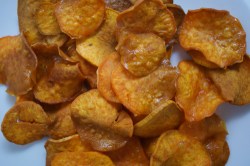I grew up wanting nothing more than potato chips and a Barbie doll. Instead, I was offered Holly Hobbie — the most wholesome, most child-appropriate doll imaginable — and carrot sticks.
The worst part is that I now deny my own child the same junk food I once sought out. He gets chips and candy as treats on vacations, and when he decides to spend his allowance on them instead of saving up for remote-control helium sharks, but his daily life is filled with suggestions that he have an apple if he’s hungry and offers of roasted almonds when what he really wants is Flamin’ Hot Cheetos.
So, like plenty of parents around the nation, I’m tempted by the notion of magical snacks that I’ll be OK buying and he’ll be happy eating. Unlike most parents, however, I work as a food writer, and sometimes companies send me their latest “all-natural” creations.
I don’t have much of a sweet tooth, so the entire category of treats made with unrefined cane sugar instead of high-fructose corn syrup flies under, over, and around my snack-dar. But anything crispy, crunchy, savory, or salty gets opened and given a shot to impress.
They’re not all good, I’ll say that much. It’s hard to improve upon the humble potato chip. And most things marketed in the “natural snacks” category aren’t necessarily any more natural or less processed than a salted potato chip, which is cause for pause.
The marketing of natural snacks hints at “not processed.” Of course, a fistful of pork fat is completely “natural” by any definition, and even unprocessed (at least before you render it), but there aren’t many who would claim it was “healthful” (and we won’t even touch on the issue of deliciousness in this case). The pushers of “natural” snacks try to focus attention on their all-natural ingredients, but as I examined one of the styrofoam-like “potato” chips covered in bright orange powder that I was admittedly happily snarfing down one day, I decided to write an article about the venn diagram of “natural” and “processed” and “healthful” in the snack world.
Since I was intrigued by process, not ingredients, I wanted to see for myself how various snacks were made. I envisioned teasing out the differences between natural ingredients and levels of processing, to see how these snacks held up to the rubric I use when deciding what to buy: Could I make them at home? In other words, are they made with ingredients readily available to retail consumers and possible to make in a home kitchen?

Molly’s homemade sweet potato chips. (See the recipe here.) They make great Thanksgiving appetizers too.
I chose a trio of crispy, savory local snacks that I actually liked the taste of and started making calls. While Somersault Snack Co. of Sausalito, Calif., was happy to let me see them bake their sunflower seed crackers if I was willing to schlep to their Central Valley factory, neither Popchips nor 479° Popcorn would let me see their snacks get made.
I asked to speak to managers and supervisors. I explained that I’d been in plenty of food manufacturing facilities, from Hodo Soy Beanery’s tofu operation to Lundberg Family Farms’ rice cake factory. I’d gone through soup factories and berry processing plants, commercial bakeries and walnut sorting lines. I’d even been to more than one of the most cautious of all food operations: creameries, where cleanliness is next to solvency and errant microbes are feared more than vampires and natural disasters combined.
On one hand, I could see why Popchips might not want me to see potatoes transformed into air-popped chips — I mean, something slightly funky is going on there, right? (For the record, Popchips cited “safety concerns” as the reason.) But why on earth wouldn’t 479° Popcorn let me see them pop corn?
“It’s a proprietary process,” I was told.
The irony? The folks at 479° had already sent me a sample P.I.Y. (pop it yourself) kit with kernels, seasoning, and instructions on how best to mimic their process in a home kitchen. How terribly secret could what they do in the factory be?
I bill myself as neither reporter nor journalist, and the ease with which I dropped that story is an excellent piece of evidence to support my claim. I did, however, file the idea away as one to follow-up on when I had some more time or came across more candidates to include.
Then The Fancy Food Show came through town last January and, despite the damage I knew it would do to my psyche and faith in humankind, I went. In addition to witnessing the trend of “tea-flavored water” and noting a surge in the availability of lentil chips, I also came across a guy demonstrating how his company (not Popchips) turned potato slices and other starchy discs (tapioca was a player, I remember that) into popped puffs.
Just as the Popchips website says, heat and pressure do the job. To make official Popchip-brand chips, though, they need to first cut potatoes down into pieces about the size of corn kernels, pop them using air pressure as well as heat, and then, along with adding oil and seasonings for flavor, somehow get those smaller pieces of popped potato to come together to form a chip.
Not only could I never do it at home, I don’t much want to.
After that, I went back to drying out kale chips in the oven and my son, the poor little lamb, went back to deciding just how often to sacrifice part of his savings to eat a few handfuls of crispy, crunchy, salty, empty deliciousness engineered to make him crave more.




